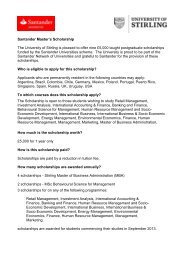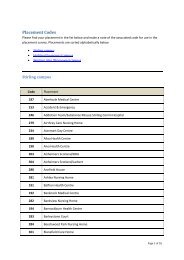Health First: An evidence-based alcohol strategy for the UK
Health First: An evidence-based alcohol strategy for the UK
Health First: An evidence-based alcohol strategy for the UK
You also want an ePaper? Increase the reach of your titles
YUMPU automatically turns print PDFs into web optimized ePapers that Google loves.
<strong>Health</strong> <strong>First</strong>: an <strong>evidence</strong>-<strong>based</strong> <strong>alcohol</strong> <strong>strategy</strong> <strong>for</strong> <strong>the</strong> <strong>UK</strong><br />
chapter 4<br />
Products and packaging<br />
Summary<br />
The <strong>alcohol</strong> industry increases its sales by creating appealing products <strong>for</strong> both existing<br />
and new, mainly young, drinkers. <strong>An</strong>y government committed to improving <strong>the</strong> health of<br />
<strong>the</strong> public should incentivise <strong>the</strong> development of lower strength products and prevent <strong>the</strong><br />
development of products designed <strong>for</strong> young people. Packaging should communicate <strong>the</strong><br />
content and harms of <strong>alcohol</strong> products to all consumers.<br />
Wherever <strong>alcohol</strong> is sold in <strong>the</strong> <strong>UK</strong> <strong>the</strong>re is an opportunity to reduce <strong>alcohol</strong> consumption by encouraging<br />
drinkers to choose lower strength and non-<strong>alcohol</strong>ic products. Because beers are taxed by <strong>the</strong> volume<br />
of <strong>the</strong>ir <strong>alcohol</strong> content, lower strength beers are widely available and are cheaper than higher strength<br />
beers. This tax regime, which offers an incentive to manufacturers to develop lower strength products,<br />
does not apply to ciders and wines; consequently lower strength wines and ciders are rare. Taxation<br />
should incentivise <strong>the</strong> development of lower strength products across all drinks.<br />
Alcohol products are designed to be attractive to consumers. Products such as alcopops and ready-todrink<br />
beverages may be ostensibly designed <strong>for</strong> <strong>the</strong> young adult market but <strong>the</strong>y also appeal to children<br />
and teenagers and <strong>the</strong>re<strong>for</strong>e encourage <strong>the</strong> early uptake of drinking. Far stronger controls are needed<br />
over product and packaging design to ensure that this does not happen.<br />
The complete lack of health in<strong>for</strong>mation on <strong>alcohol</strong> product labels is indefensible. In order to make better<br />
judgements about <strong>the</strong> risks of <strong>the</strong>ir drinking choices, consumers need both better in<strong>for</strong>mation about how<br />
much <strong>the</strong>y are drinking (<strong>the</strong> units of <strong>alcohol</strong> content per product is a basic minimum) and clear, <strong>evidence</strong><strong>based</strong><br />
in<strong>for</strong>mation about <strong>the</strong> effects of <strong>alcohol</strong> on <strong>the</strong>ir health.<br />
Public health goals<br />
• Reduce <strong>alcohol</strong> consumption by increasing <strong>the</strong> choice of lower strength and non-<strong>alcohol</strong>ic products.<br />
• Prevent <strong>the</strong> early adoption of drinking by young people, and minimise <strong>the</strong> volume of <strong>the</strong>ir <strong>alcohol</strong><br />
consumption, by prohibiting products designed to attract this market.<br />
• Increase public understanding of <strong>the</strong> harms of <strong>alcohol</strong> through product labeling.<br />
Recommendations<br />
• The tax on every <strong>alcohol</strong> product should be proportionate to <strong>the</strong> volume of <strong>alcohol</strong> it contains. In<br />
order to incentivise <strong>the</strong> development and sale of lower strength products, <strong>the</strong> rate of taxation should<br />
increase with product strength.<br />
• Wherever <strong>alcohol</strong> is sold, a soft drink should be available that is cheaper than <strong>the</strong> cheapest <strong>alcohol</strong>ic<br />
drink on sale.<br />
• The sale of <strong>alcohol</strong> products that appeal more to children and young people than to adults should<br />
be prohibited.<br />
• <strong>An</strong> independent body should be established to regulate <strong>alcohol</strong> promotion, including product and<br />
packaging design, in <strong>the</strong> interests of public health and community safety.<br />
• At least one third of every <strong>alcohol</strong> product label should be given over to an <strong>evidence</strong>-<strong>based</strong> health<br />
warning specified by an independent regulatory body.<br />
• Every <strong>alcohol</strong> product label should describe, in legible type, <strong>the</strong> product’s nutritional, calorie and<br />
<strong>alcohol</strong> content.<br />
21
















